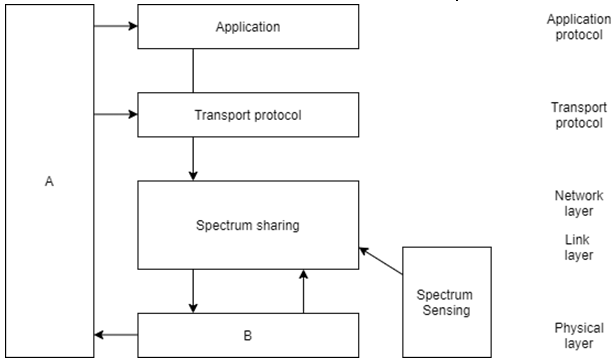This set of Cognitive Radio Questions & Answers for Exams focuses on “Next Generation Wireless Network – Spectrum Mobility – 2”.
1. What is a non-handoff?
a) xG user selects a channel from the unlicensed band
b) xG user selects a channel in the licensed spectrum band
c) xG user removes another user in the unlicensed band
d) xG user eliminates a primary user in the unlicensed band
View Answer
Explanation: Spectrum handoff is the process of changing the spectrum band and modifying the communication parameters to suit the selected spectrum band. In the non-handoff method, the xG users select an unused spectrum in the licensed band which is temporarily unoccupied by the primary user. The disadvantage of this method is the high waiting latency.
2. What is reactive handoff?
a) xG user performs sensing and sensing is performed before the triggering event
b) xG user performs sensing and sensing is performed after triggering event
c) Primary user performs sensing and sensing is performed before the triggering event
d) Primary user performs sensing and sensing is performed after triggering event
View Answer
Explanation: In the reactive handoff, the xG user begins to sense for available spectrum bands for handoff only after the triggering event. The advantage of this method is that the best available spectrum band is selected. However this method exhibits longer handoff latency.
3. Which among the following is a disadvantage of proactive handoff?
a) High latency
b) Increased number of handoffs
c) Prior planning
d) Unused saved channels
View Answer
Explanation: In the proactive handoff, the xG user continues to sense during transmission, and the handoff is carried out prior to the triggering event. Low handoff latency is observed and multiple handoffs are reduced. The disadvantage of this method is the lack of usage of back up channels and degradation of performance due to poor sensing.
4. Which among the following is a challenge for spectrum mobility in the time domain?
a) QoS maintenance
b) Cooperative sensing
c) Interference temperature measurement
d) Reconfiguration
View Answer
Explanation: xG networks change constantly in the wireless spectrum in accordance with the available spectrum band. The available spectrum bands tend to vary with time. Thus QoS maintenance becomes difficult. The radio should alter its position to meet the QoS requirements.
5. Which among the following should be adapted in spectrum mobility management?
a) Single-layer approach
b) Double layer approach
c) Cross-layer approach
d) Alternate layer approach
View Answer
Explanation: Spectrum handoff depends on the spectrum environment as well as the application requirements. By choosing a cross-layer approach, the operational overhead among the functionalities is reduced. This increases the switching time.
6. Which among the following method is suitable for delay-sensitive application?
a) Reactive handoff
b) Proactive handoff
c) Non-handoff
d) High handoff
View Answer
Explanation: In the proactive handoff, the xG user continues to sense during transmission, and the handoff is carried out prior to the triggering event. In reactive handoff, the xG user begins to sense for other bands only after the triggering event. Proactive handoff is suitable for delay-sensitive application.
7. Which among the following is influenced by spectrum switching time?
a) Transmit time
b) Access time
c) Recovery time
d) Sensing time
View Answer
Explanation: Spectrum switching time depends on hardware as well as the algorithms used for spectrum sensing, spectrum decision, link layer, and routing. The spectrum switching time caused by spectrum mobility increases the recovery time.
8. Why is inter-cell handoff required?
a) To support spectrum mobility in time domain
b) To support spectrum mobility in frequency domain
c) To support spectrum mobility in the phase domain
d) To support spectrum mobility in space domain
View Answer
Explanation: When xG users move from one cell to another, the available spectrum bands change. This demands the development of inter-cell handoff. It also demands continuous allocation of spectrum.
9. Which among the following is not a challenge of connection management?
a) Estimation of accurate latency
b) Reduction of delay
c) Reduction of loss
d) Maintenance of multiple handoffs
View Answer
Explanation: Connection management initially selects the best available spectrum band using algorithms that analyze the channel characteristics and the application requirements. Further challenges for connection management are the estimation of accurate latency, and reduction of delay and loss during spectrum handoff.
10. Which among the following is responsible for recovering the routing table in case of route break?
a) xG user
b) xG base-station
c) Primary base-station
d) Spectrum broker
View Answer
Explanation: Route breaking is likely to occur during spectrum handoff. The xG user has to recover the routing table in case of a route break. One approach is to build a new routing table for handoff and the other method is to create a routing table for the redundant channel before beginning data transmission.
11. Hybrid handoff is a combination of proactive handoff and reactive handoff.
a) True
b) False
View Answer
Explanation: Hybrid handoff is a combination of proactive handoff and reactive handoff. An alternate channel is proactively sensed before or during transmission. However handoff is performed only after the triggering event.
12. Which among the following should replace the labels ‘A’ and ‘B’?

a) Spectrum management and connection management
b) Spectrum mobility and connection management
c) Connection management and spectrum handoff
d) Spectrum mobility and spectrum handoff
View Answer
Explanation: Spectrum handoff is the process of transferring current data communication from one channel to another channel. Spectrum handoff is implemented in the physical layer. Connection management ensures that the xG user maintains the quality of service and prevents quality degradation at the time of spectrum switching by modifying the protocols associated with each layer in the OSI model.
Sanfoundry Global Education & Learning Series – Cognitive Radio.
To practice all exam questions on Cognitive Radio, here is complete set of 1000+ Multiple Choice Questions and Answers.
If you find a mistake in question / option / answer, kindly take a screenshot and email to [email protected]
